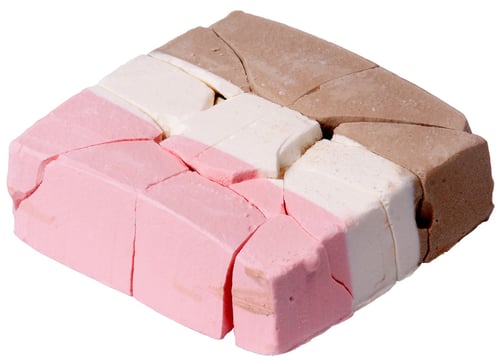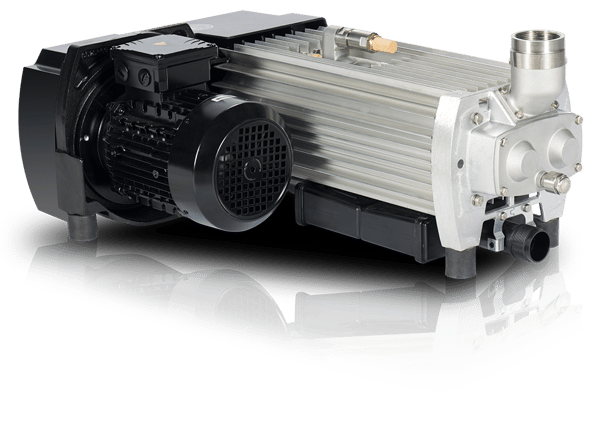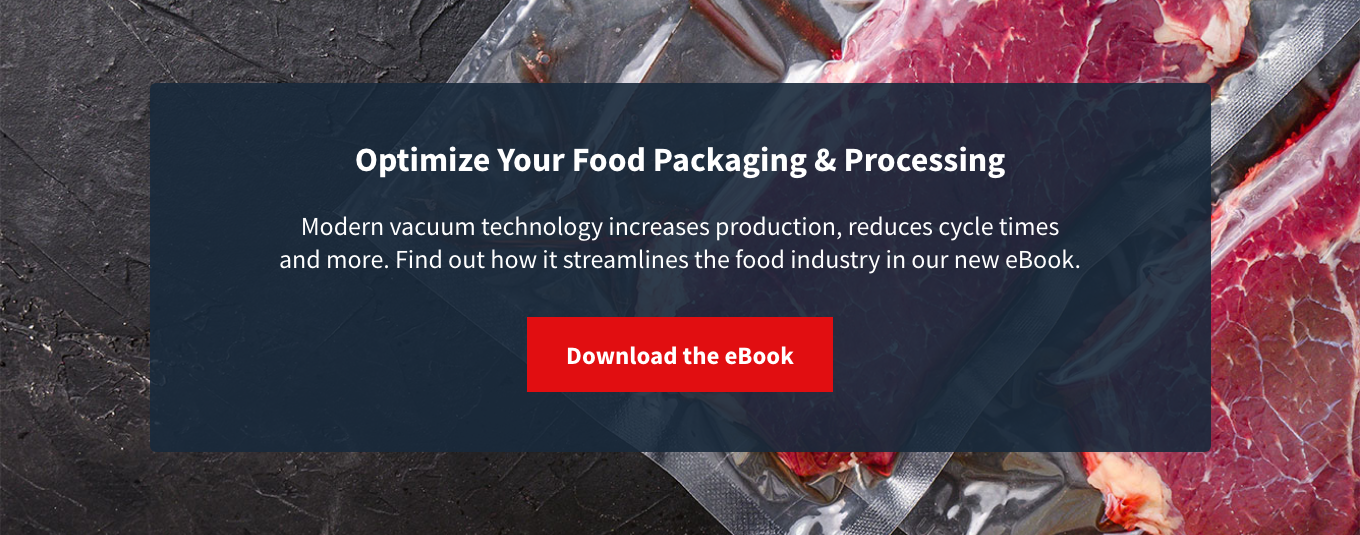Vacuum Pumps and Freeze-Drying Technology
- Vacuum Pumps and Freeze Drying Evolution
- The History of Freeze Drying
- Modern Freeze Drying & WWII
- Freeze-Dried Foods Have Many Advantages
- Vacuum Pumps and Freeze Dryers
- Maintenance Costs of Freeze Dryers
- Dry Vacuum Pumps - The New Solution
- Vacuum Pumps Today: A Cleaner and Greener Solution
- Vacuum Pumps: Defying Expectations
Vacuum Pumps and Freeze-Drying Evolution
Freeze drying, a process known as lyophilization, began thousands of years ago, but it continues to expand into the 21st century. Today we see applications for freeze-drying as a preservation or processing technique for a wide variety of applications to include food, pharmaceuticals, restoration of water-damaged materials, ceramics, and many others.
Freeze-dried food not only retains its look and feel, but its chemistry as well, ensuring essential vitamins and nutrients are maintained. The freeze-drying process became widely popular when it was used to create freeze-dried coffee, but the creation of freeze-dried ice cream made the technology seem exotic.
However to think that freeze-dried products are simply gimmicks would be to miss the exciting innovations occurring in this space. Modern freeze-drying is expanding into new markets such as freeze-dried pet food, offering a much healthier alternative for pet owners.
Modern vacuum pumps can increase your food packaging outputs by more than 20 percent per day. Many of the advances today are not only lowering the costs associated with this freeze-drying process but finding better ways to achieve the objectives of removing the moisture. Overall the quality and accessibility of freeze-dried products make this an exciting time to drive innovations.
As maintenance costs for traditional oil-filled vacuum pumps are a huge driver of production costs, many of the advances are in new, dry vacuum technology. The advantages going from wet to dry allow manufacturers to reallocate resources to other areas. This is just one example of advances pushing the industry towards cleaner, greener solutions for tomorrow.
The History of Freeze-Drying

The Incas of Peru were one of the earliest users of freeze-drying methods. Unknowingly, they created a freeze-dried process to preserve their potatoes. After the harvest, the potatoes were peeled and were left outside during the freezing cold night. Then during the day, the frozen potatoes were laid out to dry in the hot sun, the moisture evaporating. By repeating this ritual over several days, the potatoes would become frozen, dried out, then made into a powder.
This process created Chuño, and it was a staple in their diet. This powder was used primarily in stews and baking. This method kept the indigenous communities fed year-round, with safely preserved food.
These early attempts at freeze-drying were vastly less sophisticated and less consistent compared to the cutting-edge freeze-drying methods used today. In fact, freeze-drying techniques weren’t successfully used in a lab until 1890, when human tissue was perfectly dried and rehydrated for the first time.
For the next few decades advances came mainly in the form of coffee - freeze-dried coffee. Freeze-dried coffee debuted in the Americas in 1850, and was rationed out by the US Government in the Civil War. However, what the coffee gained in accessibility it lost in taste.
The next big breakthrough comes in 1937. Nestle scientist Max Morgenthaler invents a new instant coffee making method. The new product was named Nescafe.
It is at this point that freeze-drying collides with the biggest event of the 20th century: World War II.
To download a PDF version of this page, please click the link below.
Modern Freeze-Drying & World War II
After the surprise bombing of Pearl Harbor in 1941, the United States of America was thrust into a global war thousands of miles away. The American Ministry of Defence saw freeze-drying as the ideal method for preserving blood plasma and penicillin longer.
This need for the ability to provide life-saving plasma to troops in the field pushed innovations with freeze-drying technology. The technology was needed to preserve crucial medical supplies. As necessity is the mother of all inventions, freeze-drying was about to be reborn.
Freeze-drying was now needed to transport plasma to and from hospitals across the Atlantic. Because it safely preserved blood plasma, made it light enough for travel, and it was easy to rehydrate without degradation, freeze drying was quickly identified as a way to improve the treatment of soldiers in theater.
This led to advances in the techniques to preserve and transport vaccines - techniques that haven’t changed in 75 years.
After the war, the technology was applied to consumer food products. While coffee was one of the first freeze-dried products to be consumed on a large scale, today, many products, including fruits, vegetables, meats, eggs, pet food, are freeze-dried.
It was in the years from 1950s to the sixties that optimism for the future of freeze-drying looked particularly promising, especially in its application for food processing.
However, many of the dreams of that time remained unfulfilled, largely because of the higher costs of processing with oil-based vacuum pumps.
Freeze-Dried Food Has Many Advantages
Freeze drying involves freezing the product, removing almost all the moisture via a vacuum chamber, and then adding heat energy to the product, causing the ice to sublime.
Freeze-dried food has many advantages. Because as much as 98% of the water content has been removed, the food is extremely light, which significantly reduces shipping costs.
Freeze-dried food and products can also be easily transported with no refrigeration and stored for a long period of time. And because all you need to reconstitute it is water, freeze-dried food can be consumed with a minimum of preparation. They have the same exact same look and taste as the original product.
Freeze-drying food also creates a contamination-free product since the dehydration process makes it virtually impossible for yeast and potentially harmful bacteria to survive. And since the physical structure of the food is not altered during the freeze-drying process, the products retain much of their shape, texture, and flavor when prepared for consumption. This ability to reconstitute the food to a comparable state of fresh food makes it more attractive to consumers than food preserved by canning or traditional freezing.

Click below to learn more about how modern vacuum technology helps streamline the food packaging and processing industry.
Vacuum Pumps and Freeze Dryers
The freeze-drying process varies in the details of temperatures, times, pressures, and intermediate steps from one food to another. The following is a generalized description of the process with several specific exceptions noted.
- Preparation
- The food is inspected and reviewed for any contamination.
- Some food, like seafood and meats, must be cooked before freeze drying. Vegetables, on the other hand, are best raw.
- Freezing
- The food pieces are spread out on flat, metal trays and loaded onto carts for freezing.
- The coldroom where the freezing takes place contains temperatures as low as -40°(f). In these cold environments, the products are quickly frozen.
- Vacuum pumps & drying
- The drying procedure involves a process known as sublimation. In sublimation, a solid material is forced to change state into a gaseous material without ever becoming a liquid.
- The carts are wheeled out of the freezer and into a vacuum chamber. Depending on what product is being freeze-dried and the type of freeze dryer determines the rate of application of vacuum and the final vacuum pressure during drying, the rate and method of application of heat and the final dried product temperature, the allowable residual moisture content after drying.
- Sealing
- Freeze dried food can be stored for 20 - 30 years - provided they are stored properly. To prevent any contamination, most packagers use Mylar bags to seal the product. By packaging the food in a vacuum-sealed container moisture is kept out of the food.
Maintenance Costs of Freeze Dryers
When we look at the all-in costs for freeze-drying, there are many components to consider. But the constant among them is the type of vacuum that's used. For the past 60 years, the span of modern freeze-drying, the typical source of vacuum has been oil-sealed or water-sealed technology.
Oil-sealed pumps were the only game in town for years before the common freeze dryer. They provided a stable environment for removing excess moisture and generally were crucial to the freeze-drying process. But the high costs have always created an obstacle for manufacturers. This is due to the high maintenance costs of oil-based vacuum pumps. Oil-sealed vacuum pumps require monthly oil and filter changes that can result in 20-40 liters of oil being changed out each occurrence - for each pump.
After changing the oil, you have an oil disposal cost as well. These pumps also generally have exhaust filters. These filter changes, on a typical 25-horsepower rotary vane pump, can be $1000 per pump or more.
Oil changes not only result in hours of downtime but because of the constant downtime users typically keep many spare pumps on hand to remedy this problem, resulting in increased overhead costs and a higher asset base to run their business.
Oil-sealed type pumps also can have frequent pump repairs related to poor maintenance.
These all have a measurable impact on a manufacturer’s bottom line.
The other main player in freeze-drying vacuum pumps was historically liquid ring pumps. They also have very high maintenance costs due to the water usage and disposal fees associated with them. Depending on the part of the country you're in, you can see seal water temperature variations. These variations in liquid ring pumps have the same effect as water vapor in an oil-sealed pump. Higher seal water temperatures means reduced efficiency of the liquid ring pump, which translates into less CFM you're delivering to your freeze drying process. With liquid-ring pumps, you can have varying vacuum level throughout the course of the year.
Liquid ring pumps also generally have a higher energy cost because it takes a higher horsepower motor to deliver the same amount of CFM as compared to other types of vacuum pumps.
Dry Vacuum Pumps - The New Solution
Oil-based vacuum pumps utilize a thin film of oil, which runs the risk of contaminating the food. However, this process was previously deemed acceptable because there wasn’t an alternative for the longest time.
Those days are over. Today, most innovations are around dry vacuum pumps.
Dry pumps offer many advantages, including the fact that the dry screw design eliminates the presence of oil, thus eliminating the risk of the back-streaming of oil into the food. The absence of oil in the process may also increase the shelf life of the product being sealed.

While food quality and a reduction in potential contaminants may be enough to prove this solution for some, the greatest benefit may come in the form of sheer profitability increases. Dry vacuum pumps are more cost effective because they simply require less maintenance.
No oil means no downtime for oil changes and shifts the calendar for periodic maintenance from months to several years.
Vacuum Pumps Today: A Cleaner and Greener Solution
If you are packaging marinated meat, the vacuum pump will be contaminated with that marinade. Once an oil-sealed pump becomes contaminated and requires cleaning, it usually must be moved to an offsite location for maintenance.
Not true for dry pumps. With dry-sealing vacuum technology, you don’t have that problem.
The dry-vacuum pumps can be cleaned easily onsite. With Leybold’s DRYVAC and SCREWLINE dry screw pump series, one can perform an in situ liquid flushes of the pump and go back online. With the Screwline dry screw pump series, you can remove the housing, manually clean it, replace the housing again and you’re good to go. That’s a feature that only Leybold currently offers.
Dry vacuum pumps are also a cleaner solution for the environment. The pumps are truly a green solution, as they incorporate energy saving modules. They can be significantly more energy efficient, compared to oil-sealed pumps. These pumps eliminate oil vapor exhausting out of the building and eliminate the need for the disposal of contaminated oil (from the vacuum equipment).
Vacuum Pumps: Defying Expectations
The advantages of dry sealing technology have already begun to draw in many food-packaging businesses. It changes many underlying assumptions of vacuum packaging and vacuum processing.
The total cost of ownership in dry vs. oil based pumping technology is in itself a reason for the industry to take a hard look at this new alternative. Lower maintenance costs and more uptime could turn a positive ROI in as little as a year for most in this industry.
There is no doubt that Leybold is a valued partner to its customers and the industries they serve. Those adopting this new dry technology early are realizing competitive advantage, driven by their new-found process efficiencies. Leybold plans to keep pushing forward with this innovation. The company continually strives to advance vacuum technology and deliver unrivaled expertise and solutions, which not only improves the performance of its products but also provide a positive impact on their customer's bottom line.
To download a PDF version of this page, please click the link below.
Curious to find more info on our dry pumps?


